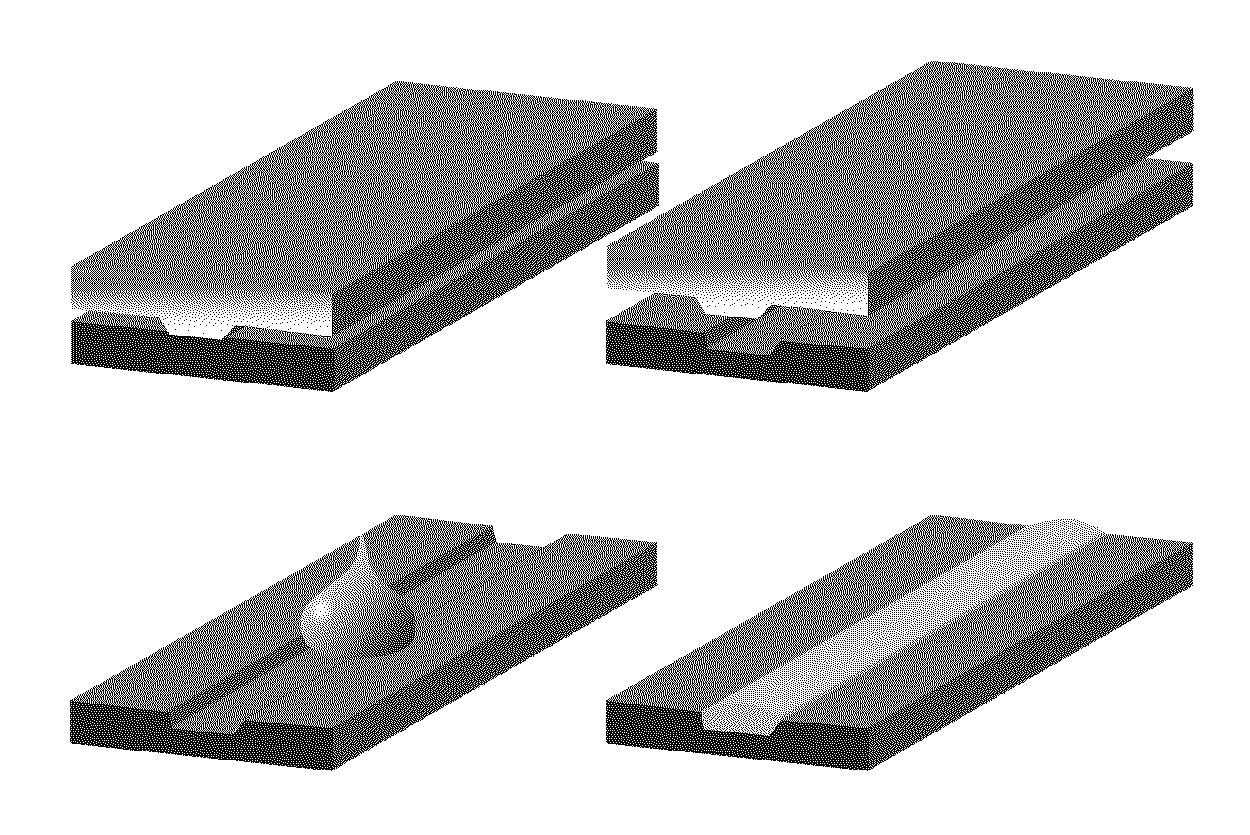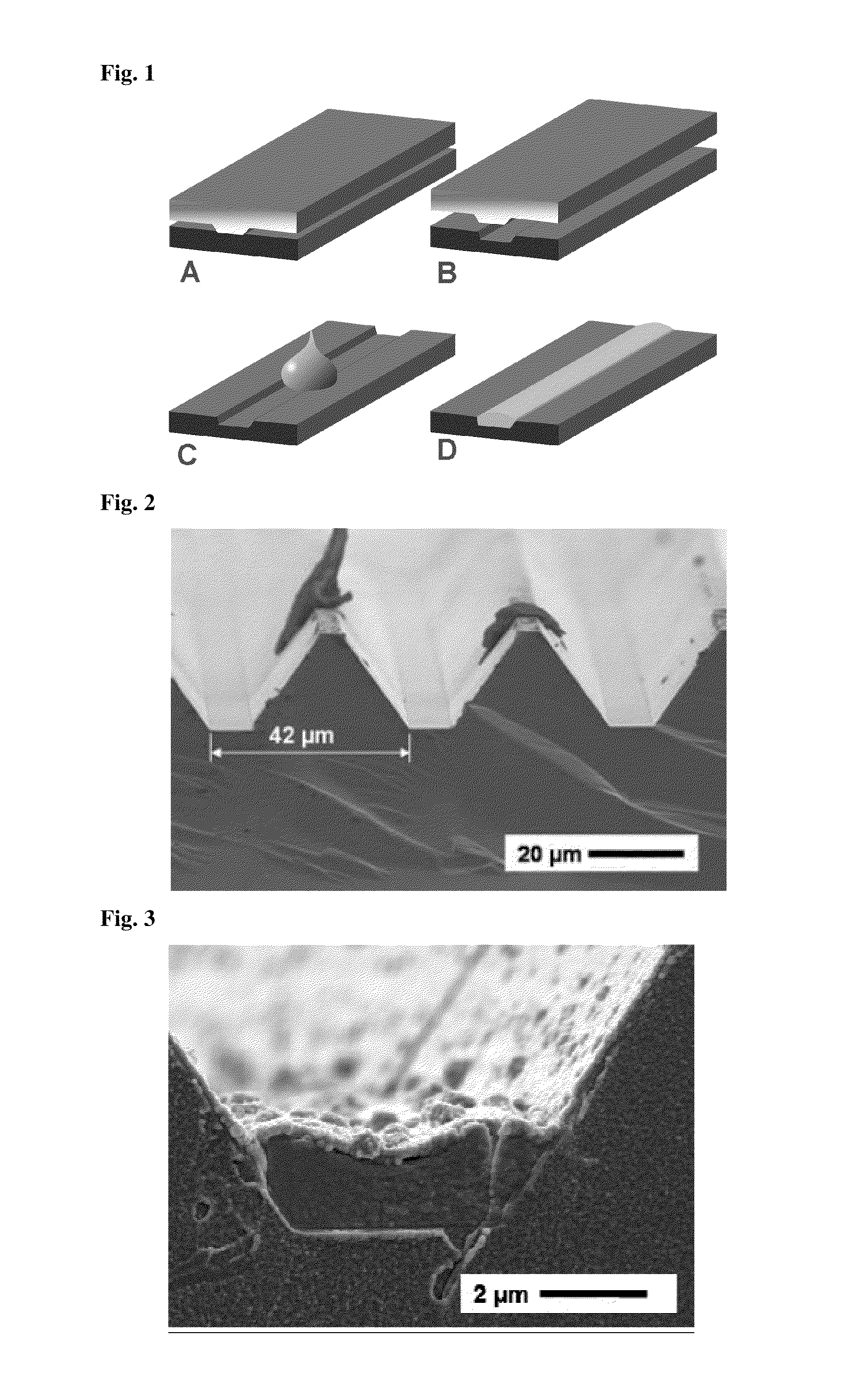Method for fabricating minute conductive structures on surfaces
- Summary
- Abstract
- Description
- Claims
- Application Information
AI Technical Summary
Benefits of technology
Problems solved by technology
Method used
Image
Examples
example 1
[0035]A grid of channels on a polymer substrate has been fabricated by pressing a grid structure (MASTER) into a polystyrene substrate with a glass transition temperature Tg of 100° C. (N5000, Shell AG). For this purpose, the MASTER was heated to 180° C. and pressed onto the substrate for 3 minutes with a load of 3 kg by means of a small press (Tribotrak, DACA Instruments, Santa Barbara, Calif., USA). The MASTER displayed a line interval of 42 μm, the depressions in the MASTER, when viewed in cross-section, appearing as cut-off triangles standing on their heads (FIG. 2). The elevations in the MASTER display a height of 20 μm and are also cut-off triangles when viewed in cross-section. The base width of the elevations in the MASTER was 32 μm and the width at the peak of the elevations approximately 4.5 μm.
[0036]A single droplet of a silver nano-ink (Nanopaste™, Harima Chemicals, Japan) was placed on one of the lines fabricated as described above. The ink consists of a dispersion of s...
example 2
[0037]A grid of channels was created by pressing a grid into a polycarbonate film with a glass transition temperature Tg of 205° C. (Bayfol®, Bayer MaterialScience AG), which was heated to 270° C. All further stamping parameters corresponded to Example 1. In the same way as in Example 1, a conductive line was also created. The line width achieved and lengths of electrically conductive silver conductor paths were identical to those of the paths created in Example 1.
example 3
[0038]The method was the same as in Example 1, but a press roller was used instead of the stamping method with a press die.
[0039]Continuous structures on a 10 mm thick polycarbonate substrate (Makrolon, Bayer, Germany, glass temperature 148° C.) were created by means of a roller mounted on a small press (Tribotrak, DACA Instruments, Santa Barbara, Calif., USA). The specially finished roller, mounted on the small press, possessed raised line structures with a width of 10 μm and an interval of 3 mm. In this arrangement, the surface of the substrate was heated to 60° C., while the roller had a temperature of 155° C. The pressure of the press was set on the assembly mentioned above by means of a weight of 10 kg. A relative drive speed from roller to substrate of 0.25 mm / s was selected for the temperatures set and the pressure used. In this arrangement, the substrate was pulled along under the roller by means of a slide, in order to achieve the relative speed indicated above. The pressur...
PUM
 Login to View More
Login to View More Abstract
Description
Claims
Application Information
 Login to View More
Login to View More - R&D
- Intellectual Property
- Life Sciences
- Materials
- Tech Scout
- Unparalleled Data Quality
- Higher Quality Content
- 60% Fewer Hallucinations
Browse by: Latest US Patents, China's latest patents, Technical Efficacy Thesaurus, Application Domain, Technology Topic, Popular Technical Reports.
© 2025 PatSnap. All rights reserved.Legal|Privacy policy|Modern Slavery Act Transparency Statement|Sitemap|About US| Contact US: help@patsnap.com


